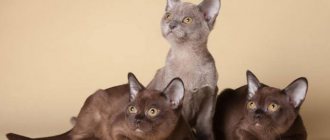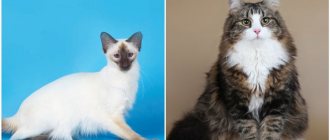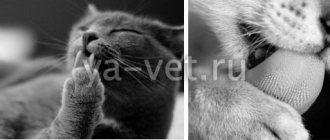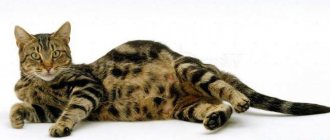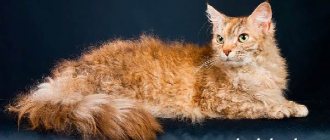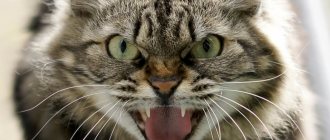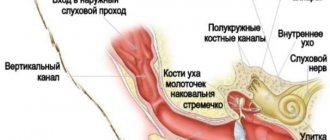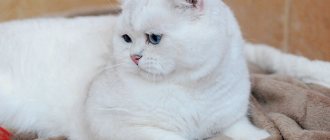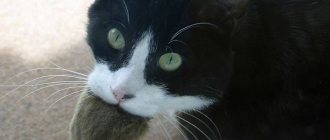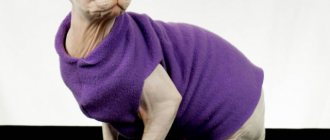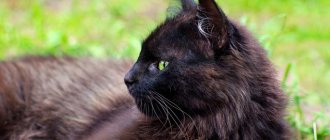If in dogs the breed can be seen at first glance, then some purebred cats are identified only by minor signs. Therefore, a kitten taken from the street can easily turn out to be of “noble blood.” But it makes no sense to determine the breed of a kitten, because with age its color can change radically. Therefore, the question of how to determine the breed of a cat remains open.
How to determine the breed of a cat
The animal is fully formed at one year of age. Then it’s time to figure out how to determine the cat’s breed. It will be difficult for anyone who is not very familiar with cats and does not consider themselves to be professional breeders to determine the breed of the pet. However, this can still be done after analyzing all external signs and his behavior. But is this necessary if the cat is already loyal and loved?
Cats that are easy to care for
It is easiest to care for medium-sized cats, which are not very active and at the same time are silent. It is better to avoid purchasing large animals such as a Maine Coon or a Bengal cat for urban living space. These cats will feel like they are in a cramped cage, which can negatively affect the character and even the health of their four-legged friend.
For a small room, it is better to select the most passive animals, the most popular of which according to the rating are: British cat, Peterbald, Scottish Straight, Scottish Fold, Burmese cat, exotic shorthair cat.
They won’t run around every room all day, knocking over everything in their path. It is extremely rare for them to show aggression; they will treat children and other animals living here very calmly.
Sometimes they are too noisy, and sometimes they are passive, sometimes capricious, but they will not cause unnecessary problems to their owners with such mischievous behavior. Living in an apartment means the pet's life is strictly confined to the premises. It turns out that you will not always have the opportunity to walk your animal, and therefore everything that is directly related to the pet will always be in your home.
And these are not always pleasant “scents” and wool is everywhere. They can be considered the usual evidence of the presence of a representative of the cat family in the house. In addition, any pet can begin to behave in a way that is not entirely predictable. You should be prepared for such surprises and not be too upset: our four-legged friends cannot always behave as well-mannered as their owners.
However, there are breeds of cats that are the easiest to care for. These include:
- all breeds of sphinxes (they have no hair, they have low activity, cats will not “mark” corners, females have no problems when in heat);
- Scottish Fold (she has a short coat, so she can rarely be brushed, she easily gets used to the cat litter, she is very clean);
- Cornish Rex (occasionally sheds, losing a small amount of hair).
Many cats easily get accustomed to the difficult living conditions in a modern apartment. By purchasing a scratching post for your cat, you will avoid scratches on your wallpaper and pieces of furniture, and sterilizing your cat will relieve you of unpleasant odors in your home.
The variety of breeds will allow you to choose the most suitable color for your future pet.
Why determine a possible breed?
First of all, a breed is not just a beautiful photo of your cat. Each breed is a genetic individual created by man. This means that the genetics of the breeds repeatedly broke down under the pressure of human will. For example, a person longed to get a luxurious breed like a Persian. And he succeeded, but in return for those external characteristics, the Persian breed paid with immunity.
Moreover, the characteristics of the breed are transmitted at the level of genetic memory. For example, outwardly a cat can be completely “noble,” but at the same time have the weaknesses of the same Persian, because there was a representative in the family. If we take this into account, the health of our foundlings will only be stronger. That's why it's a good idea to memorize such tests. Even if your Marquis looks like a king of nature in the photo, it doesn’t hurt to recognize his exemplary ancestors.
Sources:
https://catmolly.com/kak-opredelit-porodu-koshki/ https://dalmspb.com/porody/sposoby-opredelit-porodu-svoej-koshki-ili-kota-po-okrasu-117073/ https:// zen.yandex.ru/media/id/5b3ce9581577a800a9b6c6c3/5b9c6e9a7fd3ba00aafe0621
Main distinguishing features
Externally, cats have approximately the same appearance. These animals have a rump and chest of medium width, and a rounded head. Representatives of various species acquire certain features of their appearance due to selection work. These include:
- body size;
- the structure of the auricle (unusual shape, deformed cartilage, inversion, etc.);
- limbs (short, regular, elongated);
- wool;
- hair color.
Using these parameters, you can determine whether your pet belongs to a particular species. Let's look at them in more detail.
Body size and structure
An ordinary domestic cat grows up to 75 cm in length. Their tail is about 30 cm long. Standard males weigh 4–6 kg, and females weigh 2.3–4.5 kg. Some breeds weigh much more, their body weight can reach 20 kg.
The largest cat breeds include:
- American Bobtail;
- Kurilian Bobtail;
- Maine Coon;
- British cat;
- Norwegian forest cat;
- ragdoll;
- pixie bob;
- savannah;
- Turkish Van cat;
- Siberian;
- Chartreuse.
There are also small species whose weight does not exceed 2.5 kg. These include bambino, napoleon, dwelf, kinkalow, lambkin, minskin, skiff-tay-don, etc.
Paws
Most cats have limbs of medium length. But many purebred animals have short legs. By this feature, you can easily distinguish representatives of blue blood from ordinary yard animals. Short-footed animals include Napoleons, Minskins, Dwelfs, Skookums, Bambinos and Munchkins. Small paws are compensated by the mobility of the spine. Such a spine will help pets move without difficulty with short limbs.
Tail
Cats usually have a long tail. But some varieties have a short tail, which is a congenital trait and not the result of a surgical procedure. By this sign you can easily recognize purebred animals. However, you need to check whether the short tail is the result of injury. Breeds that have unusual tails include:
- Kymrik is a cat without a tail and with short forelimbs. Because of this, he has a jumping gait;
- Pixie-bob is a miniature lynx. The tail is only 2–15 cm long;
- Manx - tailless animals or with a very long tail;
- American Bobtail – the length of the tail is no more than the base of the hind legs;
- Japanese bobtail – the tail is curled and is about 12 cm long;
- Kurilian bobtail.
Even the rarest breeds can be easily recognized by the structure of the tail.
Ear shape
Outbred pets have a normal ear structure. Aristocrats' ears often have an unusual appearance:
- curved up to 180 degrees back - American curl;
- with deformed cartilage that folds the ear in half - Scottish fold cat;
- rolled up - in representatives of the Ukrainian Levka variety;
- patterned and large sizes - elf cat.
Other aristocratic breeds will have ears similar to one of the types described above.
Coat type and color
The definition of a purebred animal is always based on the coat and its color. All aristocratic varieties have their own characteristic hair colors.
Breeds differ in coat length. Short-haired varieties include Tonkinese, Siamese, Abyssinian, Singaporean, Corkt, Bombay. Maine Coon, Simrik, Persian, Balinese, and Ragdoll have long hair. There are also hairless species - Ukrainian Levka and Sphynx.
Curly short hair is found in almost all varieties of Rex: Germanic, Devon and Cornish. Hippopotamus and Selling Rex are considered curly-haired long-haired species. American Shorthair breeds have a coarse coat with elastic curls.
Varieties such as the Thai, Nevka, Balinese and Siamese have dark colored paws, muzzle and tail. The Ragdoll, Burmese and Snowshoe have white toes and a black tail, paws and muzzle area.
The Russian Blue, Briton and Nibelung are characterized by a smoky gray or blue color. Abyssinians and Somalis have a sandy coat color. Bengals, Egyptian Mau, Safari and Savannah cats are characterized by bright stripes and spots. Havana, Brown or Tiffany Chantilly have brown wool.
Mestizos can have characteristics of several breeds at once. This is a common occurrence when species are mixed. Despite the differences listed above, only a breeder or veterinarian can accurately determine the breed.
Methods for establishing the breed
When buying a kitten or choosing a partner for a domestic cat during mating, you can reliably establish the variety only by looking at it in the relevant documents from the club to which the animal is assigned (if any). If there are no such documents, then the breed is also missing.
Often, unscrupulous breeders breed cats from different breeds with each other, mate pets of the same breed and outbred cats in order to obtain offspring with purebred roots and subsequently pass them off as supposedly elite. In this case, it is impossible to judge belonging to one or another variety based on the similarity of standard characteristics. Belonging to it is determined by the following documents:
- for kittens - according to a litter certificate (if registration was carried out in an American club) or according to an individual metric (if registration was carried out in a European club), as well as according to the pedigrees of the parents;
- for adult animals - according to the pedigree, which was issued by the club and certified with a wet seal (the telephone number and address of the organization and the name of the head of the club are required).
In the veterinary passport, information about the breed is entered only at the request of the owner. Because of this, it cannot serve as a reliable means of establishing breed.
If you find an animal on the street, you should pay attention to the fact that purebred cats are rarely strays. If a street animal has any purebred characteristics, then it is most likely a mestizo.
A street cat should be taken to a veterinarian, who will need to accurately determine the variety. This is due to the fact that some varieties are prone to certain diseases, which are always transmitted to purebred offspring. In this case, the procedure is carried out according to external data.
If you have a photo of an animal, you can determine its breed in the following ways:
- If you have a digital image and have access to the Internet, you can use the online image search function, which most search engines are equipped with today. If the photo is posted in the cat owner’s personal photo album or on a specialized resource, you should contact the owner or site administrator to clarify the information.
- Go to a cat show and try to find an animal there that is as similar as possible to what is shown in the picture. For reliability, you can show the photo to judges or nursery owners, giving them a kind of test.
- Try to find in the photo any signs by which you can distinguish the breed. These may include long curly fur, curved ears, and the absence of a tail. These characteristics are usually specified in the breed guide.
Please note that the image may have been modified in graphic editors. Also, the animal can be a mestizo or obtained from the mating of outbred parents. In these cases, it will not be possible to accurately determine the variety.
Method 5. Determining the sex of a kitten by habits
Any male among cats always tries to mark his territory - these are genes. Therefore, if a kitten is constantly trying or has already begun to mark its territory, it is definitely a cat. Typically, cats begin to mark their territory at 7 months of age. In female cats, by the age of 7 months, estrus begins, that is, the cat begins to “walk” - arching her back, constantly caressing her, sticking her butt up.
Even adult cats and female cats differ greatly in their behavior. Males sleep most of the time compared to male cats. Cats constantly show how independent they are, and can even be aggressive towards people. Almost all cats love cleanliness, constantly wash themselves and always go to the accustomed toilet, which cannot be said about the representatives of the stronger sex.
And one last piece of advice.
When you decide to check the sex of a kitten, do not be rude or persistent towards the kitten. First, make friends with the kitten, gain his trust, and most importantly the trust of the mother cat. Love animals.
Why find out the breed of your pet?
When a kitten appears in the house, which was brought from the street, you can try to find out its breed. Knowing which species an animal belongs to will allow you to determine the following points:
- what size will the pet grow to;
- what character the animal will have. Each cat has an individual character. But their temperament always contains common behavioral traits of the breed;
- propensity to certain ailments. Some varieties, due to physiological characteristics, are predisposed to certain diseases. They require special care and regular visits to the veterinarian;
- what is preferable to feed;
- the optimal time for mating and producing healthy offspring.
Signs of thoroughbred
You can determine the breed of a street cat by its external characteristics. To do this, you need to arm yourself with photos and descriptions of representatives of common cat breeds. Each of them is characterized by a certain body structure, color and type of fur, shape and shade of eyes, height and weight. Knowing these characteristics, by comparison you can with a high degree of probability understand what breed an ordinary-looking pet belongs to.
Features of the body structure (shape of the skull, ears, limbs, tail, etc.)
You can determine a cat's breed by body type:
Kurilian Bobtail
- Stocky with a rounded skull, dense bones, shortened limbs. Bobtail, American and British cats have these features.
- Muscular with a slightly rounded skull and paws of medium length. If your pet has this build, it may be a Maine Coon, American Curl, or Turkish cat.
- Flexible with a rather thin body, a narrow or wedge-shaped skull and long thin limbs. These features are characteristic of Angora and Siamese cats.
Scottish fold
Ears, tail and limbs will also allow you to recognize the breed of the animal. Thus, ears tilted forward are an undoubted sign of a Scottish fold, while ears bent back are a sign of curls. Siamese cats have a long and straight tail, while bobtails have a broken tail. With shortened front legs and a jumping gait, Cymrics have no tail at all. Munchkins and minskins have disproportionately short limbs compared to the body.
You also need to evaluate the width and shape of the skull, forehead, cheeks, degree of expression of the chin, bite, and bridge of the nose. Exotics and Persians can be identified by their flattened nose, graceful Siamese and Javanese by their elongated muzzle.
"Elite" color
Siamese cat
Color in some cases serves as a determining factor in establishing the breed trait. This concept includes the color of the coat and its saturation, as well as possible patterns (tabby, agouti, etc.). Representatives of the Siamese breed are characterized by color point - a combination of a dark muzzle, paw tips, ears and tail with a lighter coat on other parts of the body.
Smoky, blue and silver colors are typical for Nibelungs, British, Scottish and other cat breeds, striped-spotted for Bengals, Savannahs, Safaris, sand for Abyssinians and Somalis, brown for Havana Browns and Chantilly Tiffanys. However, you should not completely rely on this factor when establishing the breed, since many domestic felines are colored similarly.
Eye color and shape
Muzzles of cats of different breeds
When establishing the breed of a pet, you need to look at the shape and color of the animal’s eyes. Thus, in British cats they are light brown, and in Siamese cats there is often congenital strabismus of varying degrees of severity. Turkish Angoras and Vans have heterochromia (multi-colored eyes). Among the owners of white coats of Orientals, Javanese and Persians there are blue-eyed ones. Snow-white Turkish and Scottish cats have yellow eyes with an amber tint.
Expressive almond-shaped eyes with black eyeliner are a distinctive feature of representatives of oriental breeds. Orientals, Abyssinians, Kao-Manis, Thais and Balineses have an elongated eye shape. In addition to their round, wide muzzle and thick coat, nature has endowed the Persians, Scottish Folds, Britons, Exotics and Rexes with large round eyes.
Type of fur or lack thereof
Bombay cat
The type of coat is one of the main characteristic properties of cats of noble blood. The Siamese, Singaporean, Oriental, Tonkinese, Bombay, Burmese, Abyssinian, Russian Blue, American, British, Carthusian and Exotic cats have a short length, while the Balinese, Norwegian Forest, Persian, Siberian, Somali, Turkish, Welsh, Burmese, Maine Coon and ragdoll - long. If the pet is hairless, it is probably a Sphynx, Peterbald, Minskin or Ukrainian Levkoy.
Cornish, Devon and German rexes are distinguished by curly short hair. Laperm, Selkirk and Bohemian rexes have curly and long fur. American cats have a fur coat consisting of short, hard and elastic curls.
Height and weight
These parameters can also be used to distinguish representatives of some cat breeds from others. If the cats are large and heavy, this may be:
- American or Kurilian bobtail;
- Turkish van;
- pixie bob;
- Norwegian Forest, Carthusian, Siberian, British cats;
- Maine Coon;
- savannah;
- ragdoll
Ragdoll
If your pet is too small compared to a normal cat, he may be one of the following small breeds:
- munchkin;
- minuet;
- lambkin;
- Skookum;
- bambino;
- skiff-toy-bob;
- Dwelf;
- minskin;
- Singapore.
The 20 most common cats in the world
Every year, the Cat Fanciers' Association (CFA) compiles a ranking of the most popular cat breeds. It is based on the volume of official registrations of purebred cats. So, according to the latest data, more than 2 million individuals are registered with the CFA, belonging to 42 breeds recognized by the corporation.
This time the ranking consists of 20 breeds, which are listed in the table below from last to first place.
Table 2. The most popular purebred cats according to CFA
| Name | Origin | Description |
Exotic cat | The breed was created in the 1960s after crossing a Persian cat with an American Shorthair | Wide stocky body, large paws. The coat is velvety and thick. Cats are calm and affectionate |
Persian cat | The breed originated in Persia, which is now called Iran. In the 17th century it was brought from there to Italy. In 2012-2013, it confidently took 1st place in the ratings, but later lost ground | Dense body, legs short and thick. Round massive head, snub wide nose. The coat is silky and thick |
Maine Coon | The ancestors of modern Maine Coons lived on farms in Northeast America. The name comes from Maine, where they were common. Local farmers associated them with raccoons due to their dark striped color, so they added an additional part of the name - "coon" (literally "raccoon") | A giant cat with large eyes, a fluffy tail and long hair |
Ragdoll | The ancestors of the Ragdoll appeared in California from a mixture of Burmese and Angora cats. The name comes from the peculiarity of this breed: cats completely relax in your arms and allow you to do whatever you want with them. | Large cats with long hair and a bushy tail, round blue eyes |
British shorthair cat | The first purebred Briton was bred in Great Britain in the 19th century | Massive cats with a strong body, small paws and “plush” fur. The eyes are large and protruding |
American shorthair cat | Appeared in North America thanks to the first immigrants from Europe, who brought cats on ships | Strong slender body, hard thick hairs. Round head, eyes wide open. These are independent and active cats. |
Scottish fold cat | The first representative of the fold was discovered in Scotland in 1960. It was a mutated English shorthair cat | The main feature is a gene mutation that results in “broken” cartilage in the ears |
Abyssinian cat | The oldest breed that began its journey from Ethiopia. According to legends, cats of this type were worshiped in Ancient Egypt. Some breeders suspect that the blood of reed wild cats may flow in the veins of Abyssinians | Refined elongated body, thick undercoat, triangular head with deep oval eyes. Unusually colored hairs with ticking |
Canadian Sphynx | Documentary recognition befell the sphinxes in 1966 in Canada. However, some historians claim that representatives of the breed were popular even during the reign of the pharaohs in Egypt and the Mexican Incas | Heavy body of medium size, triangular head. Prominent cheekbones and mustache pads, deep-set eyes |
Oriental shorthair cat | They were brought to Europe along with the Siamese at the end of the 19th century. The ancestors of Oriental cats lived in Thailand. The breed was finally recognized in the 70s simultaneously in the states and in England | An elongated, strong body with a long, sharp tail. Small paws, wedge-shaped head. The color is similar to “Siamese”, but without a clear color-point pattern |
Devon Rex | A cat of this breed was first noticed in Great Britain in 1960. One of the local residents managed to tame a wild pregnant cat, which gave birth to charming wavy kittens | A fragile but muscular body with curly silky hairs, huge ears. Wide head with thin graceful neck |
Siamese cat | Siamese cats first appeared in Siam (modern Thailand). From there they were brought to Europe by the English consul, where they were bred for about 200 years | Flexible, thin body, the front legs are slightly shorter than the hind legs. Characteristic “Siamese” color, bright blue eyes, large ears |
Cornish Rex | The breed was developed in Great Britain in 1950. Later, unusual kittens were crossed with Burmese and British, after which the breed was officially recognized | A small cat with a refined body, a curved back, and large ears. The main feature is long wavy hair |
Norwegian Forest Cat | The breed was bred in Norway. The ancestors of modern Norwegian cats served as assistants on Viking longships | Massive body with long waterproof hairs, triangular head with a flat nose. There are tassels on the wide-set ears, and a voluminous collar on the neck. |
Sacred Burma | The breed was bred in France in the 20s of the last century. In Burma (Myanmar) they were sure that the souls of dead monks lived in these cats, and they were kept in Buddhist monasteries | It has light long hair, pointing colors, characteristic of Siamese cats, and light “socks” on the tips of its paws. There are dark markings on the muzzle, joints and tail. The Burmese has large limbs and a massive body. Their temperament is calm, they are quick-witted and inclined to learn. |
Russian blue | The breed began its development since the times of Old Slavonic times. Outside Rus', they learned about her in 1893, when one of the cat fans took several charming kittens from Arkhangelsk | This is one of the most expensive cats in the world. Has short bluish fur that shimmers with an amazing silvery tint. |
Tonkinese cat | Bred in Vietnam. The breed was the result of crossing Siamese and Burmese cats | Well-developed muscles, slender body, slanting, expressive eyes that change color. High cheekbones and well-shaped muzzle |
Siberian cat | She was born in Siberia in 1988. She is considered the pride of Russian felinology | Medium massive body with thick waterproof coat, strong paws. Large round eyes |
Burmese cat | The first chocolate-colored cat was brought to the states from Rangoon in 1930. There she was crossed with a Siamese cat. From this union came two branches of the Burmese - American (heavier) and British (graceful) | Short silky hair, small body. Cats are muscular and strong. They have large, wide-set eyes |
Ocicat | The first cats of this breed became known in 1964 in the USA, and reached Europe only in the 1990s | They have an animal coloration, but are considered completely domestic. They can be small or large in size, with a lean body and elongated legs. Short, dense coat with spots |
Cat classification
Cats are not distinguished by a variety of external forms, which cannot be said about dogs. Even despite their abundance and distribution throughout the planet, all cats are, in principle, very similar.
Active breeding work by felinologists began only at the beginning of the last century. And even at the present moment, when a clear gradation according to breed has appeared, it is difficult to judge how many purebred cats there are in the world. It is worth recognizing that the majority of domestic cats are still ordinary “nobles,” that is, completely outbred.
To date, the cat world has about 60 breeds, which also include two hundred varieties. According to the current classification, cats are conventionally divided into 5 large groups, which differ from each other in the length of their fur and features of their body structure:
- longhaired: Burmese, Persian, Ragdoll, Turkish, Norwegian Forest, Maine Coon, Somali, Balinese, Siberian, Cymric;
- shorthaired with a strong constitution: European, American, Burmese, Chartreuse, exotic;
- shorthaired with medium constitution: blue, Abyssinian, Burmese, Bombay, Korat;
- short-haired with a slender body: Siamese, Oriental, Singaporean, Tonkinese;
- cats with deviations in skeletal structure and mutations: male, Scottish fold, bobtail, multi-fingered, sphinx, rex.
How to recognize a cat's breed by its special coat
You can understand what breed a domestic kitten or an adult cat belongs to by the length and structure of the coat. The coat of different cats can vary greatly.
Very long
Based on the long coat a kitten has, one can determine whether it belongs to a fairly large number of breeds.
The following cats have long, thick hair with a densely packed undercoat:
- Persians;
- Siberians;
- Turkish Vans;
- Angoras;
- Somalia;
- Norwegian Foresters - owners of feathers on their legs and a luxurious collar on their necks;
- Neva Masquerade;
- British Longhair;
- Himalayan;
- Maine Coons;
- Burmese;
- ragdoll, etc.
Long-haired breed - Persian cat
Longhaired British cat
Neva Masquerade - long-haired cat
Long curly
Cats of the following breeds have cute, wavy, long curls that you definitely want to touch:
- Bohemian Rex;
- laperm;
- Selkirk Rex.
Short curly
Unusual short tight curls adorn cats of the following breeds:
- Cornish Rex;
- German Rex;
- American Wirehair;
- Devon Rex.
The Cornish Rex is a breed with short, curly hair.
Hairless
Nowadays you won’t surprise anyone with bald, scary cats. Their cohort is constantly growing thanks to the efforts of felinologists and professional breeders.
Contrary to popular belief, these cats are not always completely naked. Most often they have a residual coat, according to which they are divided into breed subgroups.
It is extremely rare for a small kitten to be born completely hairless; usually the hair falls out completely later. It is almost impossible to immediately determine what it will become in the future.
Hairless cats include:
- all sphinxes: Canadian, Don, St. Petersburg (Peterbald);
- Dwelf;
- Minskina;
- elf;
- kohanu;
- bambino;
- Ukrainian Levkoy.
Hairless cats - sphinxes
Test two: color and coat of the kitten
The simplest definition is for those babies who have no fur at all. And if there are at least one or two folds on the body, then this clearly indicates the participation of the sphinx. First, let's look at the features of wool texture. If the fur is curly, curls like curls, then we have either a Devon Rex or its neighbors in the breed. If the cat's fur is long and silky to the touch, then we can assume Persian representatives or Angora cats. True, it is more effective to evaluate these breeds in conjunction with external characteristics. The unusual coloring immediately attracts a lot of attention, especially when it comes to Siamese points. Brown paws, a charming mask on the cat’s face clearly indicate that this is a descendant of a number of purebreds: Neva Masquerade, Siamese, Thai, Ragdoll. This is where some personality trait of your furry can help you. For example, an unusually sofa-like, affectionate, blue-eyed, kind kitten with a Siamese color may well be a Ragdoll cross. Conversely, the willful, characteristic individualist with the same color clearly belongs to the descendants of purebred Siamese.
Another unusual color will also attract attention: pronounced tortoiseshell or sand. And if the color is also combined with an unusually fluffy tail, then this is a Somali kitten. Long legs, elongated body and one can safely assume an Abyssinian.
Blue or silver-gray fur will tell us about the participation of a Nibelung or British cat. But if a cute baby has spots and stripes on its fur, then this clearly indicates that there are wild roots in the baby’s pedigree. Safari, Bengal, or a dozen other rare, luxurious wild cats could give rise to the birth of your baby.
Furry Pet Identification
We all know very well that domestic cats can be purebred, non-pedigreed or simply “Moggy”. Purebred pets are distinguished by certain qualities, external features, and characteristics that distinguish them from others. As a rule, they are bred by breeders, strictly observing standard qualities. This includes the size of the animal, color, exterior characteristics of the body, eye color, length of fur, tail, etc.
But it is very difficult to determine a breed by just one criterion; it is important to correlate at least several necessary qualities
Based on a set of certain exterior characteristics
Cats of different breeds have both distinctive and similar external features. Therefore, by correctly assessing the appearance of the animal, you can at least approximately understand who is in front of you: a cat of some breed or an ordinary “moggy”. How to determine the breed of a cat, knowing its external features? We invite you to consider the most interesting and most distinctive features that will be inherent and visible in both an adult cat and a kitten.
| Part of the body | Peculiarity | Possible breed |
| Body and body structure |
| Exotic or Persian breed; Savannah, Maine Coon, Norwegian Forest. |
| Ears |
|
|
| Tail | the tail is short. | |
| Paws | short, squat. | Munchkin. |
| Wool | short but curly coat; long and curly; long and straight; short smooth. |
Ashera, Abyssinian. |
| Color | dark color with white paws and muzzle; solid blue or silver color without spots; sand color; wild coloring, presence of spots, stripes. | Snowshoe, Burma, Ragdoll; Korat, Russian Blue, Scottish Fold, Chartreuse, Nibelung; Abyssinian cat, Somalia, Havanabrown, Tiffany-Chantilly; Siberian, Bengal, Maine Coon, Egyptian Mau, Savannah, Safari, Serengeti. |
According to behavioral characteristics
Behavior and habits are another way to find out the breed of a cat. The fact is that with the correct “pure-bred” crossing, all character traits are inherited. Therefore, cats of the same breed have similar characteristics. For example, cats of the Russian Blue breed are monogamous and handed over to their owner. Siamese cats, Savannah cats, Asherah cats, Abyssinian cats and others are endowed with sharp and even slightly wild habits.
The Persian cat, for example, is easy to recognize by its behavior, as it is docile and friendly. Doesn't like to be alone and will follow you around. They become very attached to humans and love to be held. But these cats are more exotic breeds, for example, the Turkish Van is not very accepting of communication, but loves to swim. Self-sufficient, but affectionate, very smart and reserved, even kittens of the Maine Coon and Egyptian Mau breeds.
By photo
To recognize a cat’s breed from a photograph, you need to know very well the main distinguishing features and at least have a little understanding of felinology. Otherwise it will be difficult, but quite possible. Look carefully at the photo of a cat or kitten, highlight some of its most remarkable features and compare it with the description and suitable parameters of different breeds. If there are similarities, you should assume that this is the representative in front of you. Of course, the most reliable way is to seek advice from a specialist.
Test one: external data
Look carefully at the kitten and determine its eye type and color. Multi-colored eyes may belong to representatives of the Angora cat. Here you also need to take into account wool. The moderately fluffy Angora has a stable gene: several litters, even half-blooded ones, inherit both an anomaly in eye color and a luxurious fur coat. Moreover, this is not just fluffiness, angora wool has a special texture, thanks to which the cat does not have tangles.
If the kitten’s nose is even slightly flattened, this indicates that Persian cats are “noted” in the pedigree. The more pronounced the peculiarity of the nose, the “closer” in generation the purebred was. Let's look at the cat's ears: they are bent back - this means that this is a descendant of a Curl. If the ears drop forward, then you have brought the heir of the Scottish Fold into the house. Please note that you need to identify signs and compare them with photos of your pets no earlier than after 8 months. It is necessary to let the kitten develop, because some signs are recognized only after some time. For example, a Scottish cat's ears fall off only a couple of months after birth.
If your baby is missing a tail, first make sure it is not the result of an accident. If this is a natural defect, then this means that you have a Kurilian Bobtail or a Cymric. There may be several varieties of breeds whose representatives are tailless.
Does your cat have external differences from ordinary cats?
How to recognize a cat's breed by external features?
Most outbred cats correspond to one gold standard: medium-sized paws, medium-wide chest and rump, and a rounded head, crowning this standard splendor.
But we're talking about exceptions, right? So, what exceptional external characteristics bring a simple cat closer to a purebred cat?
Ears
- American Curl. These are the only cats in the world whose ears are folded back. The bend can reach 180 degrees.
- Ukrainian Levkoy. A hairless or slightly fluffy Levkoy is different... Yes, in fact, this breed is different from everyone else. You can recognize it by its ears, which are literally curled up in Levkoys.
- Scottish lop-eared. Sometimes it seems that Scots don’t have ears, but in fact the problem is in the cartilage, which is so deformed that the pinna seems folded in half. The degree of bending varies from barely noticeable to almost complete fit to the head.
- Elf Kat. Americans Karen Nelson and Kristen Leedom bred a breed with wonderful ears. Indeed, it is impossible not to notice a cat with such huge patterned ears.
- The poodlecat is an exotic and artificially bred breed. Fold-eared representatives of the breed have ears that do not lie close to the head, and it is believed that the more beautiful the poodle cat is, the larger its floppy ears.
Short tail
Cats whose tail is in its infancy (or even none at all) are worth a lot. Unlike artificial docking in dogs, a cat's short tail is a purebred sign:
- Cymrik is a breed without a tail at all. From the word absolutely. At the same time, Cymrics have short front legs and a peculiar jumping gait.
- Manx are another tailless purr. True, not all of them - according to the standard, Manxes either have no tail at all or show off with a very long one.
- Pixiebob is a mini-lynx that was bred in the 80s of the 20th century. The tail of domestic predators can sometimes be two centimeters long, and sometimes even 15 cm.
- The Kurilian Bobtail is a breed in which the genes of the Japanese Bobtail and Siberian cat are mixed, bred in Russia.
- The American Bobtail demonstrates its temperament with its tail, which reaches the base of its hind legs.
- The Japanese Bobtail is a classic representative of cats with short tails. According to the standard, the tail of a Japanese bobtail should, firstly, be no longer than 12 centimeters, and secondly, the tail must be curled.
Little paws
When breeders began to breed cat breeds with short legs one after another, fears arose that in the future such pussies would have problems with mobility or the spine. But time has shown that these suspicions are unfounded, since short legs are compensated by greater flexibility of the spine.
Are your cat's paws significantly shorter than your neighbor's paws? There are several breeds for you to choose from, most of which you have already met above.
- Skookum - the dwarf La Perm has a long and wavy coat. Another feature of the breed is its pronounced collar. By the way, the breed was originally called poco chino (Small Curly).
- Dwelf - without hair, without long legs.
- Munchkin
- Napoleon
- Minskin
- Bambino
Siberian
The Russian cat breed originated in the Siberian forests as a result of crossing domestic breeds with wild steppe ones. Siberian cats are distinguished by their strong physique and thick, dense fur coat; due to these two factors, individuals look like real giants.
The weight of an adult animal can reach 12 kg, the size of cats is somewhat smaller, but they still remain quite strong, and at the same time harmoniously built cats.
The main feature of the breed is the coat; it is long, the undercoat is short, dense and thick, perfectly protecting the individual from the cold. The obligatory attributes of the breed are thick pants and a collar, hair between the toes, tufts on the ears; Siberian cats are distinguished by self-sufficiency, intelligence, strong and bright character.
A Siberian kitten can be bought for 10 thousand rubles.
The main differences between purebred pets and domestic ones
A purebred cat always has one or more distinctive characteristics that allow it to be classified as a particular breed. This could be an interesting color, unusual ear structure, iris color, etc.
These qualities are fixed by the standard, so representatives of the same breed are quite similar to each other. But the differences between cats of different breeds can be dramatic.
Non-pedigree cats differ much less from each other in appearance. They can be identified by the following unifying characteristics:
- medium-sized, high-set triangular ears sticking straight up;
- regular shaped round head;
- elongated, graceful body of correct proportions;
- muscular, long paws with soft pads and sharp claws;
- well-set round eyes;
- an energetic and agile long tail that well expresses all the cat’s emotions.
How to properly care for a purebred cat?
Any pet, whether outbred or noble blood, needs decent care. The following procedures will be relevant for all breeds:
Nail trimming and combing
We trim the claws. Nails should be trimmed using a veterinary nail clipper. The most important thing is not to damage the living part of the nail. The vessels on the transparent claw are easily visible. You need to step back 2-3 mm from them and cut off the tip.
Tips for trimming cat's claws
The animal will struggle, so the procedure must be carried out with an assistant. We comb the pet. Cats with luxurious long hair need to be brushed twice a day, and pets with medium-length hair need to be brushed every 3-4 days. The voluminous coat is combed out with a slicker brush and combed with a simple comb.
Hygiene
The list of regular hygiene procedures for cats includes:
- Teeth cleaning. Your pet's teeth should be brushed at least once a week using a cat brush/finger brush and veterinary toothpaste. It is better to instill in your kitten a love for this process from an early age;
- Water procedures. It is not necessary to wash cats often, as water causes them great stress. Bathing is recommended only if the cat is very dirty or before a show. Use special shampoo from a pet store. You can read more about how to wash a cat on our portal.
- Eye wash. If discharge appears near your pet's eyes, you need to rinse the eyes with warm water and a cotton swab. If the discharge is cloudy, you need to show the cat to a veterinarian;
- Ear cleaning. The ears should be regularly inspected and wiped with a special solution if dirt appears. Otherwise, serious illnesses may develop.
Wool
Pedigree cats have a wide variety of coats. Long-haired, short-haired, hairless - this is not the entire list of nuances that should be taken into account when caring for the coat of your “aristocrat”. Different breeds have different hair structures, so each of them requires an individual approach. Basic tips for caring for your pet's fur are presented below.
Hair care for purebred cats
Exhibitions: how to get there and why?
Purebred cats and cats of noble breeds receive the right to participate in exhibitions. People gather at these events for various reasons: some people win prestigious titles with their pets, some simply want to communicate with passionate cat lovers, and some want to find a purebred pet for themselves.
WCF Direct Member Certificate
The largest international organization of cat lovers is the World Cat Federation (WCF). It includes 540 clubs from all over the world. WCF holds an average of 300 cat shows annually, a third of which are in Russia.
What does it take to get to a cat show?
Anyone can come to the cat show, but you can only take part with a pet that is already 3 months old. In order for your pet to be included in the list of participants, you need to prepare the following documents:
- a certificate with notes on vaccinations and antiparasitic treatment;
- certificate from a veterinarian in form No. 1 for a period not older than 3 days or in form No. 4.
Important! The exhibition organizers may require additional documents, so for each exhibition the set of papers should be clarified in advance.
